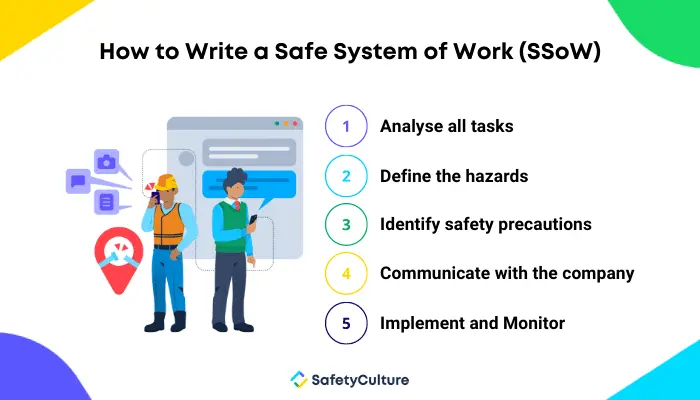What is a Safe System of Work?
A Safe System of Work (SSoW) is defined as a procedure or a set of procedures for removing or reducing the risks involved in an operation. In the field of Health, Safety, and Environment (HSE) in particular, SSoW standardises most, if not all, practices in the workplace to help ensure that employees don’t get injured, either by the equipment that they use or through other means.
Why is a SSoW Important?
Ideally, all companies should have set SSoW procedures in place. Having established SSoW procedures not only improves existing safety measures, but also ensures employee safety while keeping the quality of work in check.
In some countries, it is legally required to have a SSoW in place. Particularly, in the UK, under the Health and Safety at Work etc Act (HSWA) 1974, employers are required to provide systems for work that are practical and safe. The same act also has provisions for equipment safety, emission safety, and substance safety as supplements for creating a SSoW. Although the name for SSoW may vary, countries like Australia, Hong Kong, and Ireland also have similar laws mandating a SSoW.
SSoW, paired with a well-implemented general integrated management system can help your organization meet legal requirements for safety and compliance.
Improve your EHS Management
Cultivate a safe working environment and streamline compliance with our EHS solutions.
Explore nowHow to Write a SSoW
Each SSoW guideline may differ per industry and organisational needs. However, these are the general steps in creating them:

How to Write a Safe System of Work (SSoW) | SafetyCulture
1. Analyse all tasks
Before anything, you need to clearly define what exactly are your necessary and unnecessary tasks and the risks that come with them. Look at all their aspects to identify and understand where risks could manifest themselves and what could be done to manage or avoid them.
Then, ask your employees what they think of their tasks. There may be risks that you or your management may have missed, so it is always best to consult your employees directly to better understand the jobs that they do.
In case some tasks are deemed unnecessary to the job and pose too great a risk to employee safety, immediately eliminate them from your processes or lessen their frequency. Instead, focus on essential tasks and what could be improved upon regarding overall workplace safety.
2. Define the hazards
The next step in creating a SSoW is to identify the hazards involved in each task. A hazard is anything that could potentially cause damage to something or someone, and there are many kinds of hazards involved in various jobs.
Some of the most common hazards are:
- Unchecked equipment: Different jobs call for different equipment. However, poorly-maintained equipment is likely to cause more damage than good. It can result in injuries such as burns and cuts and expose employees to harmful emissions.
- Weather: The weather is not something we can control, which is why it could be a potential hazard. While it is true that some jobs are more easily done in sunny weather and are harder to do when there is rain or snow, while some jobs are the opposite, there should still be precautions in place in case the weather takes a drastic turn. Excess heat can cause heat stroke and excess cold can result in the flu and other illnesses usually associated with cold weather. Organisations should also prepare for storms, especially if they have employees working in open areas or out in the field.
- Chemicals: Chemicals can cause burns, fires, and even severe allergic reactions in employees. They can also contribute to environmental damage.
- Electricity sources: Electrical wiring is a common hazard in many workplaces. If neglected, they may cause severe incidents in the workplace.
- Heights: When tasks are performed at elevated heights, there is a higher risk of employees dropping objects or falling down themselves from the elevated area.
- Repetitive movements: A common but overlooked hazard in the workplace is the hazard of repetitive movements. Too much repetitive movement can create tension in the joints and muscles, leading to soreness and injury.
3. Identify safety precautions
Now that hazards have been defined, you must identify what safety precautions can be taken and how. Some precautions may work but may not be as effective as others. This is a step that requires constant communication with your employees and other stakeholders to fully understand which precautions would work well with certain job types and are most effective at keeping your employees safe.
4. Communicate with the company
Once safety precautions have been identified, you can start developing your SSoW. Discuss your findings with managers and employees and see what they think about it and ask them if they have any suggestions. Create your system with them so that nothing will be missed and all concerns are addressed.
A typical SSoW includes the following:
- the steps required for each task;
- the risk and hazards employees are expected to face;
- what should be done when risks emerge;
- who to call in case of an emergency; and
- an analysis of how the event happened.
5. Implement and monitor
There are formal and informal ways to implement SSoW. A simple way to implement SSoW is to create Standard Operating Procedures (SOPs). These procedures can be made for a variety of purposes, but a common goal is to promote safety in the workplace, hence why they are counted as part of SSoW. SOPs and other kinds of SSoW guidelines may be documented on paper or through checklists, announcements, and word of mouth.
However, it’s important to remember that implementation continues even long after SSoW guidelines have been set. Monitoring is also crucial as things may change over time and different circumstances may require a change in SSoW guidelines.
Digitize the way you Work
Empower your team with SafetyCulture to perform checks, train staff, report issues, and automate tasks with our digital platform.
Get Started for FreeHow SafetyCulture (formerly iAuditor) Can Help
For the implementation and monitoring of your SSoW guidelines, you can use SafetyCulture to ensure employee safety and legislation compliance. With SafetyCulture, you can conduct inspections on the go to see if your SSoW guidelines are being implemented as intended and upload your findings to the app where everyone can have access to them. SafetyCulture is available on both desktop and mobile (both Android and iOS) making it easily accessible to everyone.
SafetyCulture can help you do the following and more:
- keep track of hazards identified and injuries sustained to better understand how to mitigate and manage their impact as well as prevent them from occurring again in the future;
- use or create templates to standardise inspections;
- create reports based on inspections done to see frequencies and trends;
- collate everything into one place for easy access;
- schedule inspections and maintenance checks;
- assign specific actions to personnel; and
- report issues observed, even outside of the designated inspection time.




